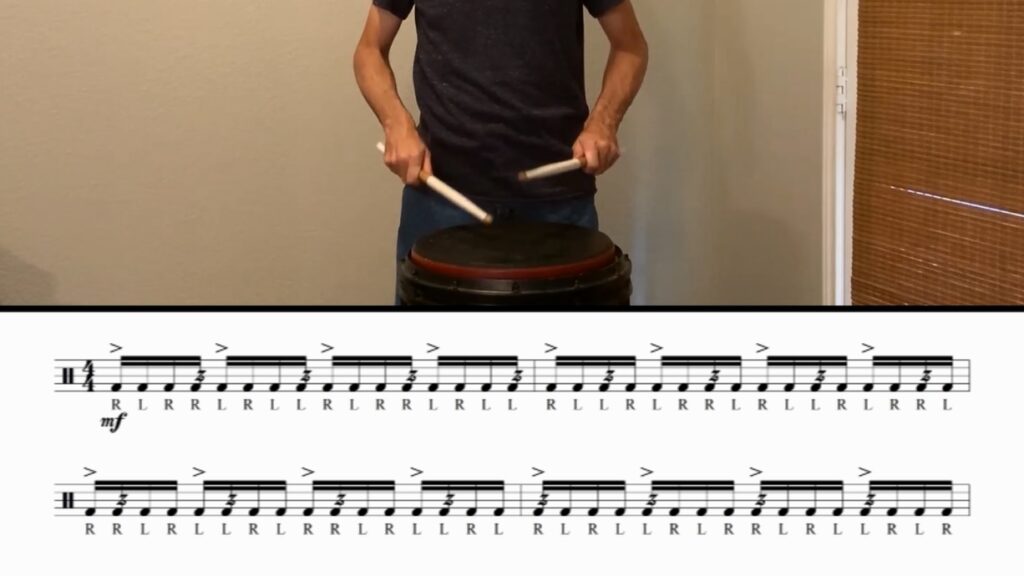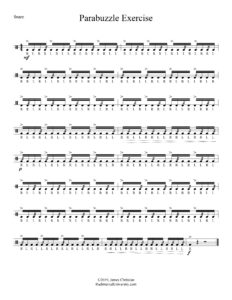Here is a new snare drum exercise that utilizes the buzz, buzzle, parabuzzle, and several variations.
Click “Read More” to watch the video and download the sheet music.

Here is a new snare drum exercise that utilizes the buzz, buzzle, parabuzzle, and several variations. Watch the video to learn the exercise.
You can download the sheet music below. A full transcript of the video follows.

TRANSCRIPT
Introduction
Hello, everyone. This is James Christian with Rudimental University. I haven’t posted any videos in a while, and I apologize for that. But I have a lot of really cool things lined up in the near future, so subscribe to make sure that you don’t miss any of those.
The Buzzle
Today we are going to do a short exercise based on a rudiment called the “buzzle.” I first heard about buzzles in an article written by Chet Doboe of Hip Pickles fame. And it was published in Modern Drummer Magazine.
A buzzle is basically a double, or a diddle, with a buzz on the second note. So it sounds like this: [demonstration]
So those are fun to play on their own. Now you can use them in any rudiments that have a double in them. Today we’re going to do some variations on paradiddles and use buzzles within the diddle part of a paradiddle.
The Parabuzzle & Variations
So the first one is just a regular paradiddle, and those are called a “parabuzzle.” And they sound like this: [demonstration]
Now if you were to take a paradiddle and start on the second note, sometimes I’ve heard those called “inverted paradiddles.” But whatever you want to call them, that’s what we’re going to do. We’re going to start on the second note of a parabuzzle, and it would sound like this: [demonstration]
And then if you started on the third note–sometimes I’ve heard these called “backward paradiddles.” Or they’re also like a single flammed mill without the flam on it. So I’ve heard them called “mills” as well. But it’s like we’re starting on the third note of a parabuzzle: [demonstration]
And finally, starting on the fourth note of a parabuzzle. As far as paradiddles go, I’ve heard these called “reverse paradiddles.” Or you can think of it as just a backwards quad. It’s basically a quadruplet–four singles in a row–and then they alternate each time. But again, whatever you want to call it, it’s the fourth variation, and it sounds like this: [demonstration]
Parabuzzle Exercise
So we’re going to take all of those variations. And you can have whatever names you want for them. I’m just going to call it variation #1, #2, #3, and #4.
And the first part of the exercise is going to start on variation #1, then #2, then #3, then #4. And then go backwards to #3, #2, #1. And that’s a seven-measure phrase. So on the eighth measure, we’re going to do a measure of straight 16th note buzzles. And just for good measure, we’re going to decrescendo it down to a soft dynamic.
And then the second half of the exercise will start softly, and we’re going to do it in reverse. It’ll start with the fourth one, then the third, then the second, then the first. And then it will go back to #2, #3, #4. And then again, we’ll finish off with a measure of 16th note buzzles. And we’ll crescendo it to the end.
So I will play it at two different tempos: One fairly slow, so that you can learn it. And then I’ll put it at a fairly moderate tempo, and see if you can keep up.
[demonstration]Conclusion
And that is the parabuzzle exercise. If you would like to download a copy of it to practice for yourself, you can get it at RudimentalUniversity.com. And the link will be included in the description.
For all future updates, make sure you subscribe. If you like this video, please like it, comment: tell me what you did or didn’t like about it. And I’d love to hear from you. So stay tuned, and I will see you next time. Bye!
